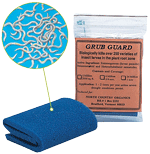
Grub Guard

Sizes Carried
- 1 million (2,000 Ft2)
- 6 mil (¼ acre)
- 24 mil (1 acre)
- 240 mil (10 acres)

Grub-Guard is a mixture of two thoroughbred strains of nematodes called Steinernema sp. and Heterorhabditis sp. We refer to them as thoroughbreds because, unlike most beneficial nematodes which are raised on a dog food-like substance, Grub Guard nematodes are raised on insects (in vivo). Although this process is more costly than rearing on artificial media (in vitro), we believe this technique produces a much more aggressive strain.
We use two different strains of nematodes because of their different abilities. Steinernema sp. are shallow soil dwellers that occupy the top 1-3 inches of soil. These nematodes are ambushers and attach themselves to soil particles near the soil surface waiting for prey. Heterorhabditis sp. burrow down as deep as 5-6 inches, offering a secondary barrier to grubs that are emerging from or submerging to winter soil depths. Because Heterorhabditis sp. reside deeper in the soil, they are less susceptible to drought conditions. Heterorhabditis sp. are hunters that follow grub exudates through the soil. Both species act by invading grub or larval bodies through orifices, such as the mouth, anus, or spiracles, where they release bacteria that are symbiotic to them but deadly to the larvae. The bacteria multiply and produce enzymes that destroys the hosts protein.
Larval death occurs in 24 to 48 hours. Grub Guard nematodes soon begin reproducing the next generation of offspring, which mature and reproduce another generation, which then reproduce a third generation. The SF nematodes require both a male and a female to reproduce but the Heterorhabditis sp. can develop into a hermaphrodite and reproduce asexually. Steinernema sp. cycle in about 7 to 10 days from infection to emergence and Heterorhabditis sp. takes about 12 to 15 days. By this time the food supply from the host has been depleted and Grub Guard nematodes emerge in numbers that will often exceed 100,000. All of these hungry, microscopic juveniles go off in search of new larvae for the proverbial bed and breakfast retreat.
Grub Guard nematodes are shipped alive and should be released into a thoroughly moist soil or growing media as soon as possible. They can be stored for a short period of time (about 1 month) under refrigerated conditions (40-50o F) but the small sponge that Grub Guard nematodes are shipped in must be kept damp and the package should be left open to allow fresh air to enter. Add a few drops of water if the sponge appears to be drying out. When mixing, the ideal water temperature is between 65o and 80o F. DO NOT USE HOT WATER. Grub Guard nematodes are nocturnal and should be released in the evening or at night.
Grub Guard nematodes will survive at soil temperatures between 32o and 90o F. However, they are most aggressive at temperatures between 65o and 85o. They cannot survive at soil temperatures above 90o or below 32o F. Reapplication may be necessary if the soil reaches beyond these extremes. Grub Guard nematodes are very sensitive to sunlight. After 7 minutes, exposure to ultraviolet light will sterilize the nematodes. Therefore, it is crucial that Grub Guard nematodes be watered into the soil quickly and thoroughly. Irrigate if necessary before applying to ensure that the environment is sufficiently moist. Applications in the early evening or early morning are recommended. Grub Guard nematodes can be applied through any modern liquid delivery systems and can withstand pressures up to 300 p.s.i. Filters should not be smaller than 50 mesh (i.e., 50 openings per linear inch or 0.020 sized opening). Optimum soil moisture for nematodes is ~15%.
Like most beneficial organisms, Grub Guard nematodes should be applied in anticipation of a grub problem. The “ounce of prevention vs. the pound of cure” rule is most appropriate with any predator insect. Concentrate the Grub Guard nematodes where problems are most likely to appear.
FOR TURF: Grub Guard nematodes can control many different varieties of lawn insects such as Japanese beetles, Asiatic beetles, European and masked chafers, sod webworms, June and May beetles and armyworms.
FOR GREENHOUSES: Grub Guard is an excellent control for fungus gnat larvae, shorefly larvae, thrips and other greenhouse pests that spend part of their life in the soil.
FOR FIELD CROPS: Grub Guard nematodes will parasitize many field crop pest larvae including onion maggots, strawberry root weevils, cabbage root maggots, flea beetles, black vine weevils, cutworms, carrot weevils and many others.
Orchard Crops : Grub Guard is an effective control of many soil-born pests that do not migrate from surrounding areas.
Other Uses : Grub Guard nematodes will attack and kill over 250 varieties of insect larvae in the plant root zone. Almost any species of plant feeding insect that spends part of its life in the soil is susceptible to attack by Grub Guard.
Application Recommendations
- Irrigate for 15 – 30 minutes immediately prior to GRUB GUARD application to cool irrigation equipment and surrounding soil surface to temperatures below 85 F.
- In the spring: Apply when soil temperatures are above 35 F. In the fall: Apply when soil temperatures are above 55 F.
- GRUB GUARD is compatible with most pesticides and fertilizers. Refer to the Grub Guard Compatibility Table for specific products that are not compatible.
- A nematicide should NOT be applied within 14 days before or after application of GRUB GUARD.
- Use cool water (50 – 80 F) to dilute and apply GRUB GUARD.
- Triple rinse GRUB GUARD into feeder tank.
- Agitate GRUB GUARD in feeder tank during mixing and application.
- Prepare spraying equipment by removing or replacing screens that are U.S. mesh size 50 or smaller.
Mixing and Dilution
- Saturate and squeeze the contents of the sponge or flask into tank water under active agitation. Rinse the sponge or flask several times.
- Water temperatures should be between 50 – 80 F.
- Tank agitation must be active during filling and application to ensure complete and even dispersion of the product.
- Pump pressures should not exceed 300 PSI.
- The GRUB GUARD suspension may be held in the agitated tank for up to 24 hours. Keep tank cool (under 80 F).
APPLICATION PROCEDURES
Chemigation
- GRUB GUARD can be applied through fertilizer injection systems: wheel-line, in-line, fixed-line or other sprinkler type systems.
- Irrigate for 15 – 30 minutes immediately prior to starting GRUB GUARD injection to cool irrigation equipment and soil surfaces.
- Add GRUB GUARD to a clean feeder tank. Suspension must be continuously agitated during injection to prevent GRUB GUARD from settling. Calibrate the
injection pump to deliver the concentrate over a one-hour period or longer for uniform coverage. - After injection, rinse feeder tank with clean water and inject into system.
- Follow post-application irrigation instructions.
Subsurface Application
- GRUB GUARD can be soil-applied using shank, cultivator or spoke-wheel applicator.
- Apply GRUB GUARD in 30 – 100 gallons of water per acre.
- Shank: Apply as a trickle behind each shank at a 2 – 4 inch depth followed by a press wheel to cover opening.
- Cultivator: Apply as a spray immediately in front of a rolling cultivator. Incorporate to a 2 – 4 inch depth.
- Spoke-wheel: Double spoke-wheels should be placed 6 – 8 inches apart and centered on the bill. Inject at a 2 – 4 inch depth.
Ground Spraying
All Surface Spraying Equipment
- Apply GRUB GUARD with a minimum of 100 gallons of water per acre.
- Soil should be moist before beginning application.
- Soil temperature should be between 35 – 85 F.
- Follow post-application irrigation instructions.
IRRIGATION REQUIREMENTS
- Prior to application, ensure that soil is thoroughly moistened to the full depth of the root zone.
- Surface application: Following application of GRUB GUARD, immediately irrigate with 1/4 – 1/2 inch of water.
- Subsurface application: Irrigate field no later than 3 days following application.
- For maximum GRUB GUARD performance, maintain adequate soil moisture for 21 days.
OMRI LISTED™ – View OMRI Certificate
For more information, download the product label pdf
 North Country Organics
North Country Organics